Japandi style merges the clean lines of Japanese design with the warm, rustic charm of Scandinavian aesthetics, creating a cozy yet minimalist kitchen vibe. It’s all about balance—think simple cabinetry, natural materials, and a harmonious color palette. Dive into these kitchen ideas that will help you embrace this serene and functional design approach, making your cooking space a welcoming retreat.
1-Handcrafted Pottery and Tableware
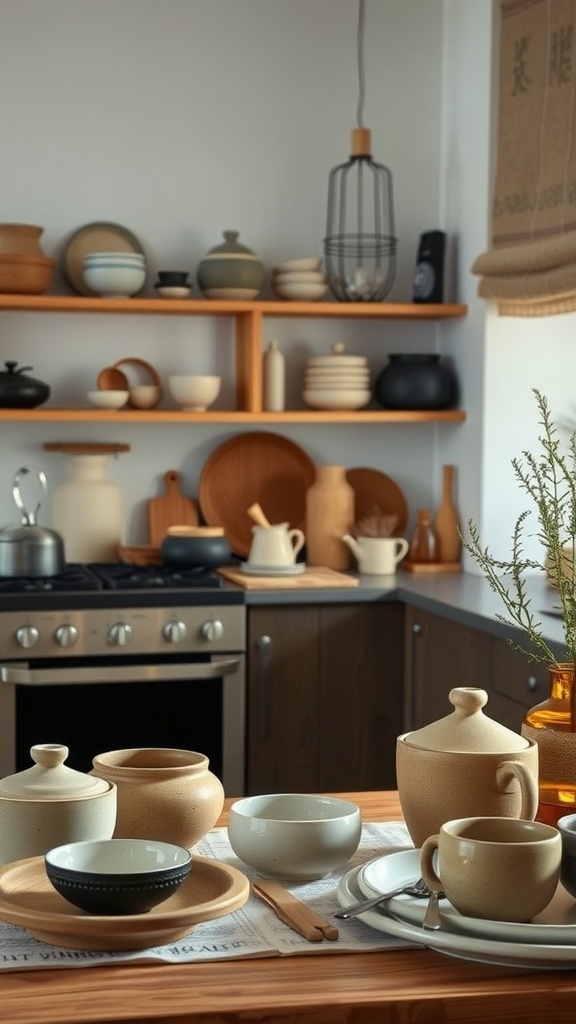
In a Japandi style kitchen, handcrafted pottery and tableware play a crucial role in creating an inviting atmosphere. The warm tones and natural textures of these pieces bring a sense of calm and simplicity to your space.
The image showcases a beautiful collection of pottery that perfectly complements the minimalist design of the kitchen. Each piece tells a story, highlighting the craftsmanship involved in creating these unique items. From bowls and plates to teapots and mugs, these handmade pieces add character and warmth.
When choosing pottery, consider how the colors and shapes can enhance your kitchen decor. Earthy tones like browns, whites, and soft pastels work well to maintain a soothing ambiance. Mixing different sizes and styles can add an interesting visual element without overwhelming the space.
Using these pieces not only elevates the dining experience but also encourages a connection to the art of cooking and serving. Imagine gathering with friends and family around a table set with these lovely dishes, enjoying home-cooked meals in a cozy setting.
2-Japanese Zen Inspiration in Decor
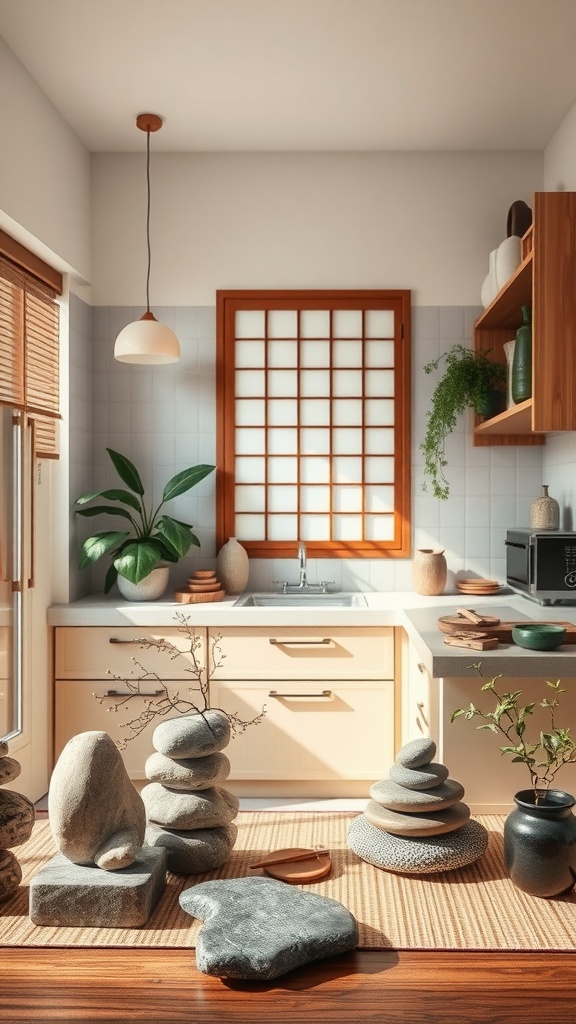
When you think of a kitchen infused with Japanese Zen inspiration, this image perfectly captures that essence. The light that pours in from the large window creates a warm, welcoming atmosphere, highlighting the simplicity and tranquility of the space.
The use of natural materials is key here. Notice the beautifully arranged stones on the countertop. These elements not only add a touch of nature but also promote a sense of calm, reflecting the Japanese principle of wabi-sabi, which appreciates the beauty in imperfection and transience.
The kitchen features a minimalist design with clean lines and neutral tones. The muted colors combined with wooden accents make it feel cozy while maintaining a sleek look. Plants, like the one in the corner, breathe life into the space, emphasizing the importance of nature in Japanese design.
Additionally, the traditional shoji-style window adds a unique touch. It allows diffused light to enter while providing privacy, enhancing the peaceful vibe of the kitchen. This design choice beautifully integrates modern functionality with classic aesthetic elements.
Incorporating these elements into your own kitchen can create a serene retreat. Consider adding simple decor, natural materials, and plants to evoke that Zen feeling. A few thoughtfully placed stones or a branch in a vase can transform your kitchen into a tranquil sanctuary where you can enjoy cooking and gathering with loved ones.
3-Minimalist Color Palette for a Japandi Kitchen

The Japandi style blends Japanese minimalism with Scandinavian functionality. This kitchen exemplifies that harmony beautifully. The warm wood tones create a cozy and inviting atmosphere, while the clean lines and organized layout emphasize simplicity.
In this image, the color palette is soft and neutral, featuring whites, light wood, and earth tones. This combination not only promotes a peaceful environment but also makes the space feel more expansive. Natural materials like wood and ceramics enhance that connection with nature, which is key in Japandi design.
Notice how the decorative elements, such as the woven baskets and minimalist vases, add character without overwhelming the space. Each item serves a purpose while contributing to the overall aesthetic. The green plants bring in a touch of life, reminding us of the beauty of the outdoors.
If you’re looking to create a Japandi kitchen, consider using a similar color scheme. Stick to soft, muted tones and incorporate natural materials where possible. This approach not only looks appealing but also fosters a sense of calm that you can enjoy every day.
4-Functional Wooden Shelves for Storage
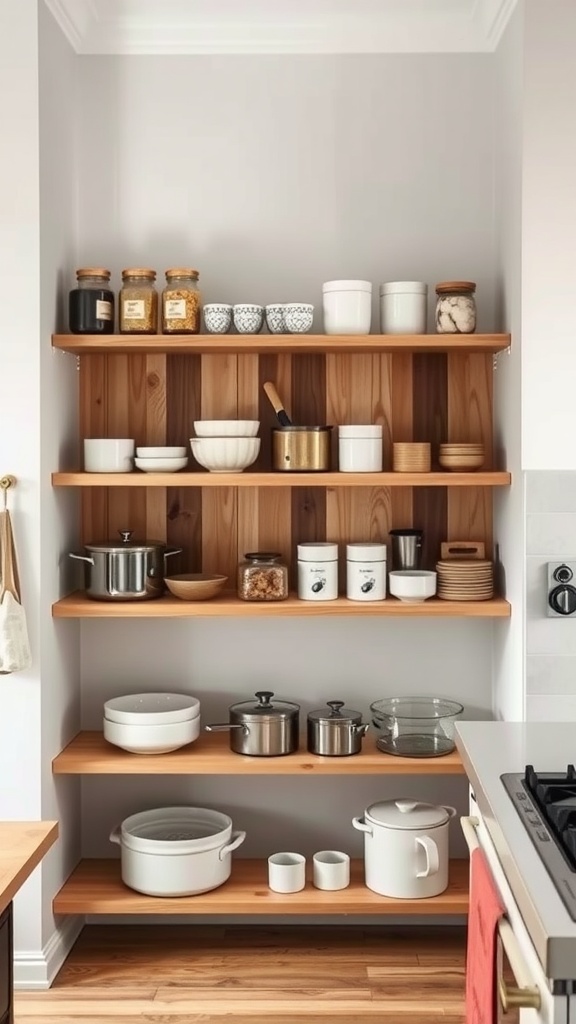
Wooden shelves are a key element in Japandi style kitchens, blending functionality with a warm aesthetic. The image highlights how these shelves can be arranged neatly, showcasing both beauty and utility. You can see various containers and bowls, all neatly organized and easily accessible.
The arrangement of different heights and shapes adds interest to the space. The use of natural wood tones complements the light walls, creating a cozy atmosphere. It’s a reminder that storage doesn’t have to be hidden away; it can be part of the decor.
This open shelving concept encourages you to display your favorite kitchenware and ingredients, making cooking a more enjoyable experience. Whether it’s jars of spices or your best dinnerware, showing them off can add personality to your kitchen.
To achieve this look, consider using wooden shelves that match the warmth of your kitchen. Mixing different sizes of containers can create a playful vibe, while uniform items can bring a sense of order. Remember, the goal is to find a balance between form and function.
5-Open Concept Layout for Fluidity
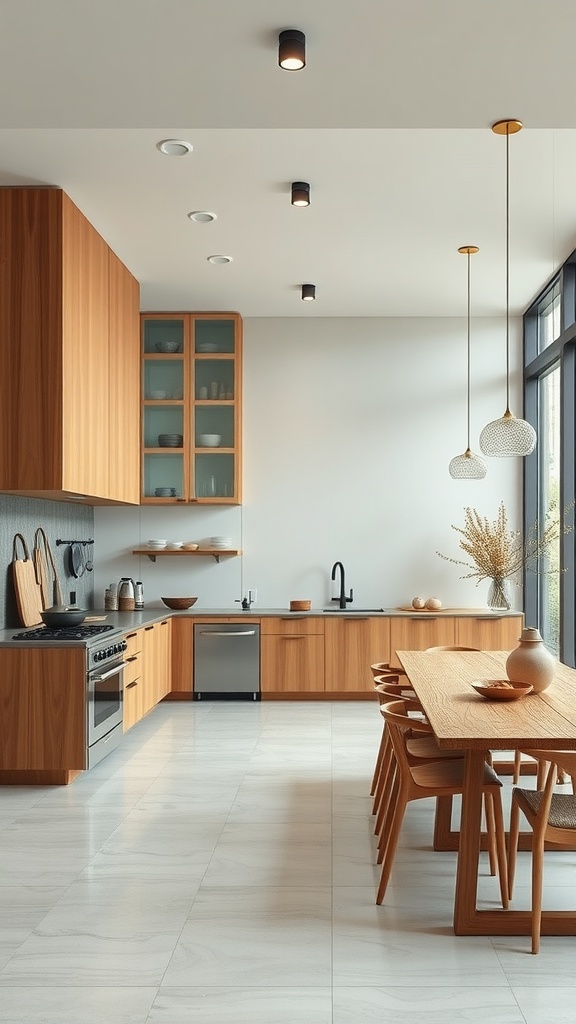
The Japandi style kitchen thrives in an open concept layout, promoting a sense of fluidity and spaciousness. In the image, you can see how the kitchen seamlessly flows into the dining area. This design encourages interaction and makes the space feel larger and more inviting.
Notice the warm wooden cabinetry and modern appliances that create a balanced aesthetic. The natural wood tones, combined with sleek black elements, reflect the Japandi philosophy of combining Japanese minimalism with Scandinavian functionality. It’s all about creating a cozy yet uncluttered environment.
The long dining table is a focal point, perfect for gathering with family or friends. Its simple design mirrors the overall theme of simplicity in Japandi style. Large windows allow plenty of natural light to spill in, enhancing the connection between the indoors and outdoors.
When planning your own open concept kitchen, think about how to maintain an airy feel. Use light colors for walls and countertops, and consider furniture that complements the overall theme. The goal is to foster that peaceful, harmonious vibe that Japandi is known for.
6-Modern Scandinavian Lighting Fixtures
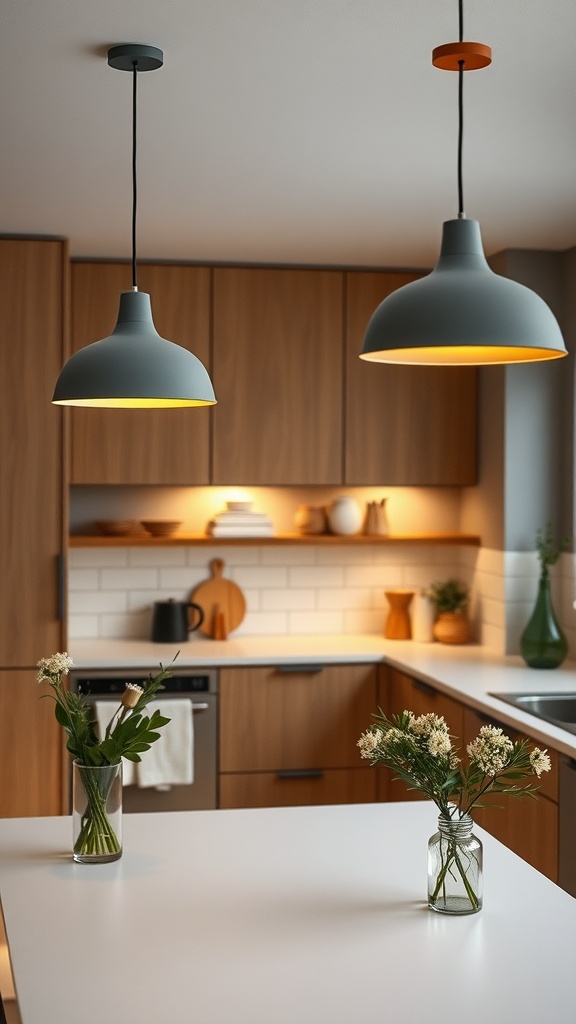
The kitchen in a Japandi style beautifully blends modern Scandinavian design with Japanese minimalism. The lighting fixtures play a crucial role in creating the perfect ambiance. In the image, two pendant lights hang gracefully over the kitchen island, showcasing a mix of muted colors.
The first light has a soft gray finish, providing a warm glow that complements the natural wood cabinetry. The other light, with a hint of orange, adds a playful touch while still maintaining a cohesive look. This combination reflects the Japandi ethos of simplicity and functionality.
These lighting fixtures not only serve as practical elements but also enhance the kitchen’s aesthetic. By choosing designs that are sleek and understated, you can achieve a calm atmosphere, ideal for cooking or entertaining. Pairing these lights with fresh flowers in simple vases adds a touch of nature, further elevating the serene vibe of the space.
When selecting lighting for your Japandi kitchen, consider how the colors and shapes of the fixtures can harmonize with your overall design. Opt for materials that reflect the earthy tones and textures present in both Scandinavian and Japanese styles. This thoughtful approach to lighting can transform your kitchen into a welcoming haven.
7-Integrated Appliances for a Sleek Look
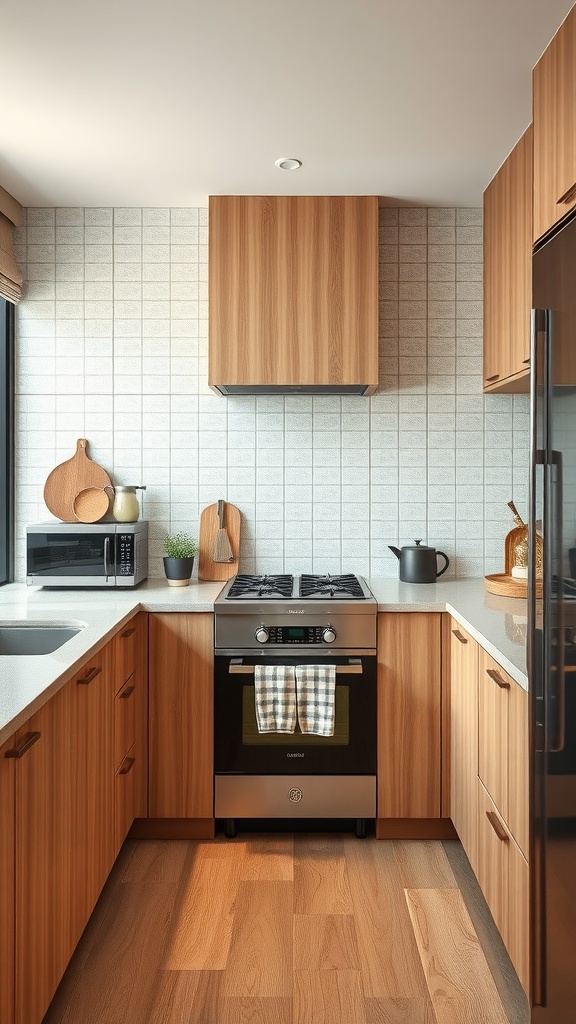
In a Japandi style kitchen, integrated appliances play a key role in achieving a clean and uncluttered look. The image showcases a cozy kitchen with warm wood tones and modern fittings, perfectly balancing functionality and aesthetics.
The stove and microwave are seamlessly incorporated into the cabinetry, allowing the natural beauty of the wood to shine through. This design choice not only conserves space but also enhances the minimalist vibe that defines Japandi style.
Notice how the sleek lines of the appliances complement the overall design. The black oven stands out just enough against the wood, creating a visual interest without overwhelming the space. It’s all about harmony and simplicity.
When selecting appliances, consider those that blend well with your cabinetry. Look for options that can be built into your kitchen for a seamless finish. This approach helps maintain the serene environment that Japandi decor aims for, making your kitchen a calm, inviting space to cook and gather.
8-Natural Materials and Textures in Design
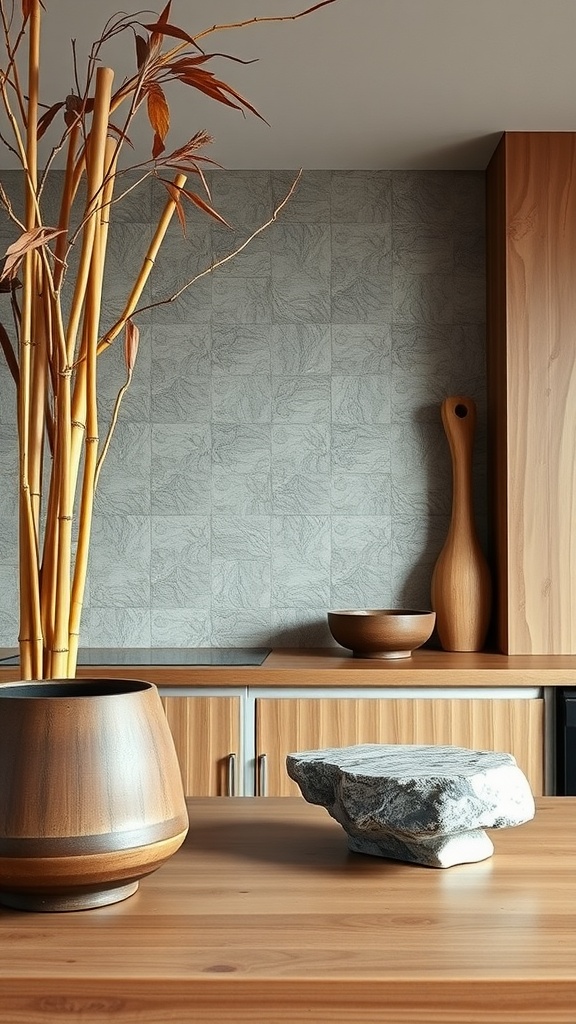
The beauty of Japandi style lies in its embrace of natural materials and textures. This image showcases a serene kitchen setting that perfectly exemplifies the philosophy behind this design trend. Here, we see warm wooden elements paired with simple stone features, creating a harmonious balance that speaks to both Japanese and Scandinavian aesthetics.
The tall bamboo arrangement adds a touch of nature, bringing the outdoors inside. Not only does this contribute to a relaxing atmosphere, but it also integrates organic shapes and colors into the space. The soft hues of the bamboo complement the rich tones of the wooden bowl and the sleek countertop, enhancing the overall warmth of the kitchen.
The stone centerpiece is another striking element, providing a contrast to the smooth surfaces around it. The combination of textures—from the sleek wood to the rugged stone—invites touch and interest, making the kitchen not just a place for cooking, but also an area for appreciation and enjoyment.
By incorporating these natural materials, the design reflects a commitment to simplicity and sustainability. It encourages a mindful approach to living, reminding us that the beauty of our surroundings can enhance our daily experiences.
9-Greenery and Indoor Plants for Freshness
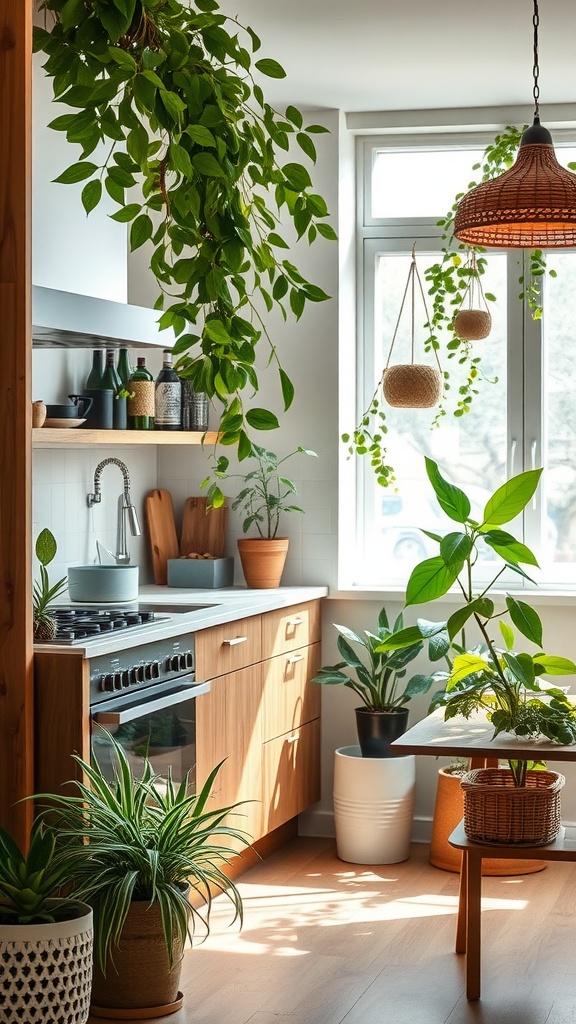
In a Japandi style kitchen, bringing the outdoors in is essential. The image showcases a warm, inviting space filled with lush greenery. Plants hanging from the ceiling and adorning countertops create a vibrant atmosphere. These elements not only enhance the decor but also promote a sense of calm.
Incorporating indoor plants is a great way to add freshness to your kitchen. The presence of greenery can improve air quality and provide a natural pop of color. You might choose easy-to-care-for plants like pothos or snake plants, which thrive in various lighting conditions.
The arrangement of plants is important. Grouping them together can create a mini indoor garden effect. Consider placing a few pots on the kitchen table or near the window where they can soak up sunlight. This not only adds charm but also makes your cooking space feel lively.
Don’t forget about hanging plants! They can save counter space while adding visual interest. Macramé hangers or simple baskets can elevate the look. Create a balance between the greenery and the kitchen’s functional elements for a cohesive design.
10-Functional Dining Nook for Family Gatherings
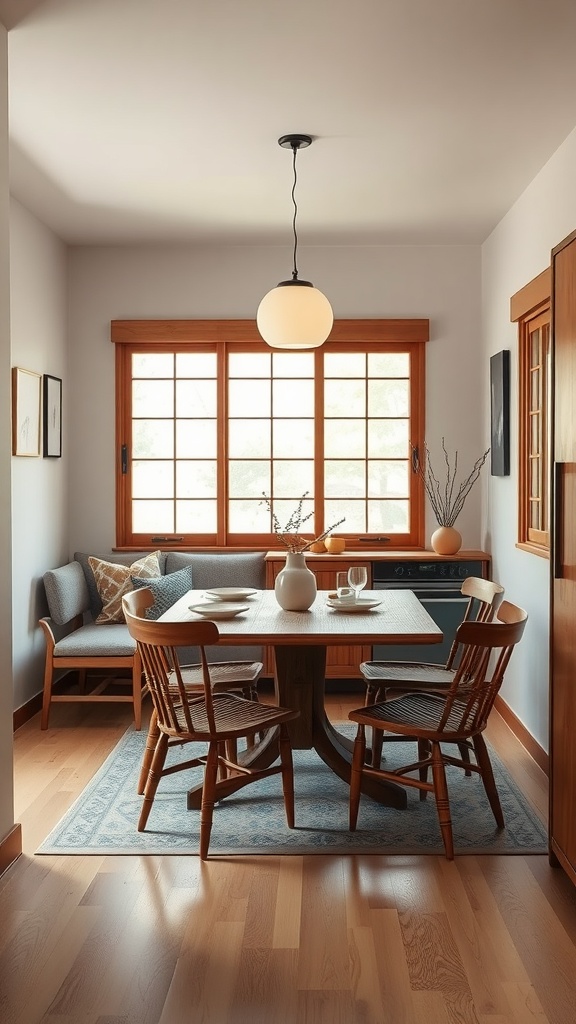
This cozy dining nook captures the essence of Japandi style, blending simplicity with functionality. The inviting space features a robust wooden table surrounded by comfortable chairs, making it an ideal spot for family meals or casual gatherings.
The large windows allow natural light to fill the room, enhancing the warm tones of the wood and creating a cheerful atmosphere. Soft cushions on the bench add a touch of comfort, inviting family members to settle in for a long chat over dinner.
The minimalist decor keeps distractions at bay, letting the focus remain on togetherness. Simple table settings with elegant dishware and a vase of fresh flowers add charm without overwhelming the senses.
Incorporating a dining nook like this into your kitchen promotes family bonding while maintaining a clutter-free aesthetic. It encourages shared meals and moments, essential in today’s fast-paced world.

